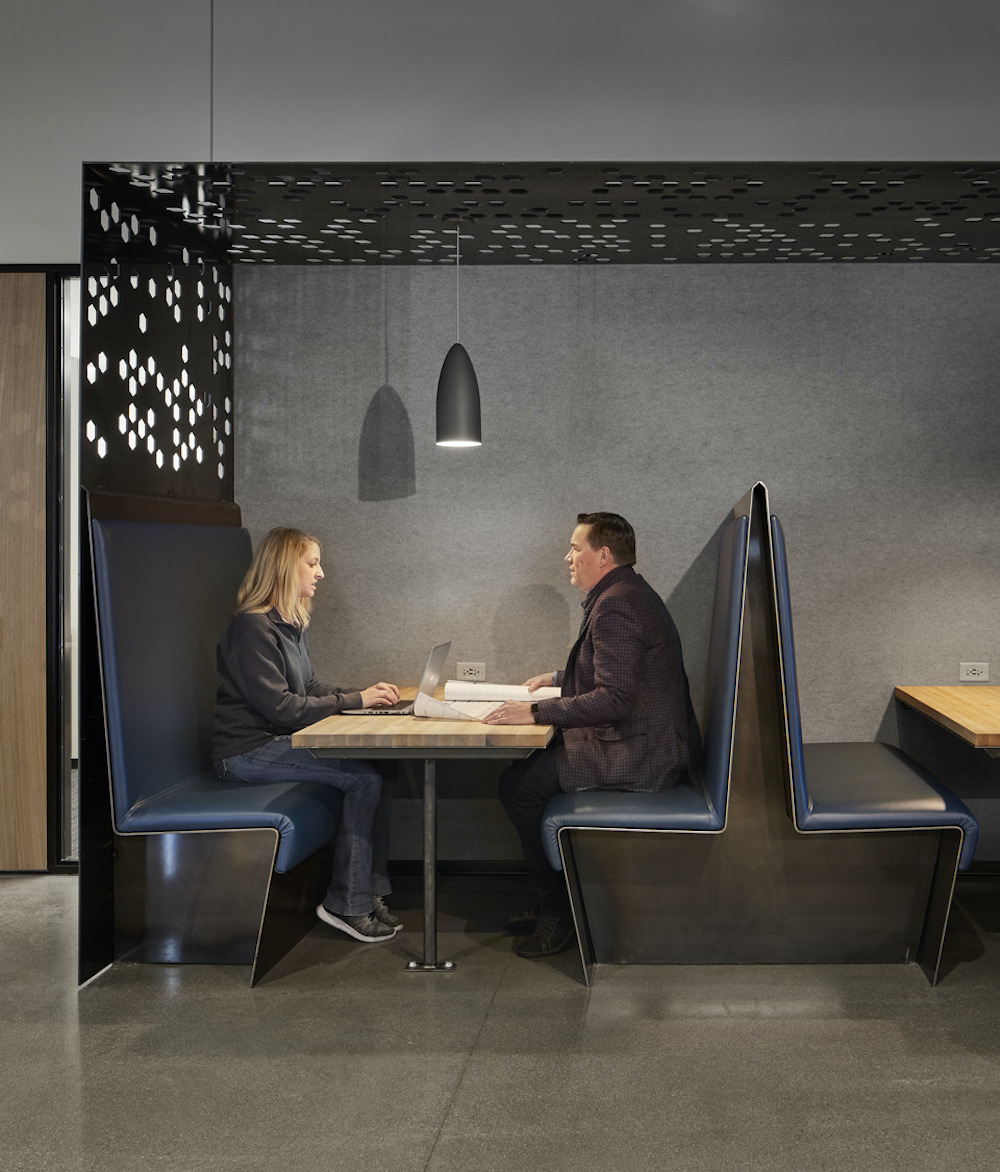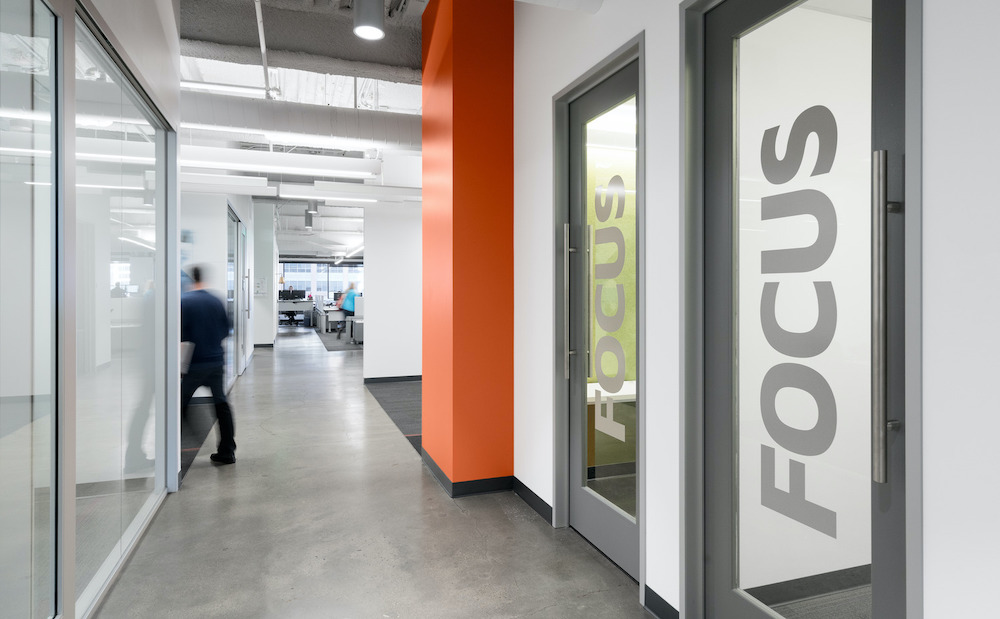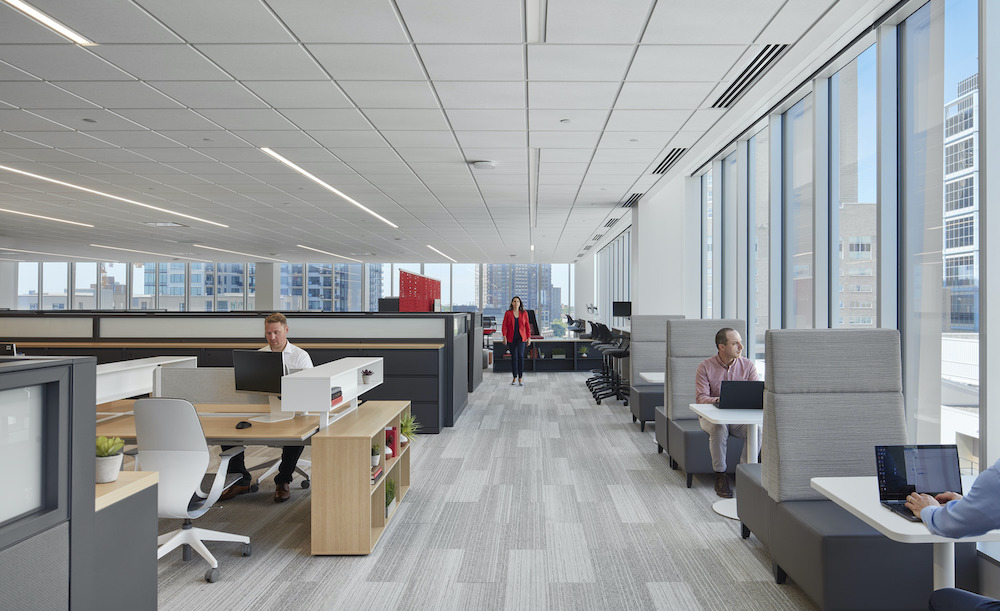Terri Zborowsky, Julie Mendoza-Lollar, and Heather Bachman of HGA share why designing for neurodiversity starts with understanding how people with different ways of thinking can feel comfortable in the workplace.
For decades, design professionals have endeavored to make workplaces universally accessible for everyone. Until recently, however, we have just focused on ensuring that people with physical disabilities have equitable access to all building areas and that the spaces they occupy provide them with a sense of safety, comfort, autonomy and dignity.
Now, lessons learned from remote and hybrid work experiences, labor shortages and a growing understanding of how people who are neurodivergent can fuel innovation, (Hewlett, et. al, 2013) improve efficiency and boost productivity (JLL, 2022) have prompted us to expand our definition of “universal design” to address the needs of people with neurodivergent conditions, such as autism spectrum disorder (ASD), attention-deficit/hyperactivity disorder (ADHD), dyslexia, dysgraphia, dyspraxia and Tourette Syndrome.

The Neurodiversity Spectrum
Designing for neurodiversity can seem daunting because individuals with neurodivergent conditions exhibit such a wide range of characteristics and behaviors. For example, while some people with neurodiversity are hypersensitive and become quickly overwhelmed by noise, lighting and various sensory cues, others may be hyposensitive and have a diminished response to environmental stimuli.
Additionally, advances in medical and mental health diagnostics have led some experts to estimate that as many as one in five people have a neurodivergent condition (Doyle, 2020), and there is a widespread recognition that everyone — including people considered to be “neurotypical” — is somewhere on the neurodiversity spectrum (Fitzell, 2021).

Since neurodivergence touches most of our lives, whole-brain design, which addresses the rich and varied ways people’s brains process, retain and utilize information, should become as integral a part of our professional practices as meeting the unique needs of differently abled individuals.

Expanding Our Approach
Universal design principles already address how to create healthy work environments that optimize users’ comfort, productivity and wellbeing. For example, we strive to achieve an ideal layering of direct, indirect and natural lighting based on the function of each workspace. Since most people find noise irritating, we use acoustical panels, room dividers, insulation, sound-masking systems, furnishings and finishes to dampen sound and prevent echoes and reverberation.

Designing for people with neurodiversity, however, requires a slight shift in our approach to a workplace design process. Traditionally, in programming, we ask our clients “what do you need?” so we can generate a list of functional requirements. However, since neurodivergence is experienced across a full spectrum of possibilities, we need to understand how people with specific conditions are affected by design alternatives. So, it is important to include them on advisory committees where they can provide input from preliminary research sessions through post-occupancy reviews. This will help us to better define the users’ activities and needs in each space. The more we understand, the better we can design for them. If we’re able to conduct a post-occupancy evaluation to understand the impact of our design decisions, we gain insights to inform how best to approach whole-brain design.

Unique Challenges
Since a standard program document consists of a list of rooms, we typically use a multiplier to calculate the amount of circulation space needed. We haven’t thought as much about how to sequence and connect the activities transpiring within these spaces. Yet, it’s especially critical to tackle these issues upfront when designing workplaces to support people with neurodivergency, as they generally prefer predictability and sameness.
For example, individuals with ASD can experience “visual gestalt perception,” which causes them to perceive all aspects of a space simultaneously. This can make it difficult for them to recognize a single feature and separate it from the whole. A small change in the environment, such as moving a piece of furniture or switching out art, can make a space feel unfamiliar and cause frustration. Some people with neurodivergent conditions prefer simplicity because they can only recognize objects within the context and location where they first saw them.

Design Strategies
Organizing workplaces into distinct zones based on their sensory qualities, developing a predictable sequence of spaces, providing transitions, buffers and thresholds and layering a variety of wayfinding systems to provide redundant cues and clear sightlines can alleviate stress for people with neurodivergent conditions.
Zoning
It is particularly challenging for people with neurodivergent conditions to concentrate on “heads-down” tasks when there are a lot of distractions. This can be addressed by considering macro- and micro-level zoning considerations—from zoning an entire workplace to zoning desks based on what type of activities might be occurring at each individual workstation, This can establish compartmentalized zones based on the activities occurring within them (i.e. collaboration or hands-on vs computer work), grouping these zones together according to their sensory stimulation (high or low) and providing transition spaces between them.
Sequencing
Since many people with neurodivergent conditions have an affinity for routine, organizing and sequencing spaces in the order that activities occur throughout the workday can reduce anxiety.
Transitions and Buffers
A workplace’s spatial organization should provide places for Recreation facilities, courtyards and gardens can serve as buffers between high- and low-stimulation zones. They also provide places where everyone can take a break from intense work activities, socialize and enjoy access to fresh air.
Thresholds
By varying ceiling heights, finish colors and floor and wall materials, designers can create thresholds that allow users with neurodivergent conditions to pause, reset and prepare for moving between spaces with markedly different levels of sensory stimulation.
Wayfinding
People with neurodivergent conditions can become overwhelmed quickly while searching for the sensory cues they need to confidently reach a destination. Artwork, signage with legible text and realistic images, distinct architectural elements, fixed furniture arrangements and exterior views of landmarks are examples of how redundant sensory cues can make the journey through a workplace more comfortable and intuitive. Offering unobstructed vistas of upcoming spaces and integrating “peek holes” into the design of corridors and transition areas can have a calming effect by allowing people to see into spaces from a safe vantage point and better anticipate what to expect.

Choices and Adaptability
Individuals with neurodivergent conditions often have more intense responses to sensory stimuli. Thus, enabling them to control key workplace environmental factors can reduce anxiety while increasing comfort and productivity. Design strategies that support these goals include:
- Providing control over the amount and intensity of natural light entering a workspace to mitigate glare, reflections and extreme contrasts that can distract people’s attention.
- Specifying dimmable light fixtures and controls.
- Sub-zoning collaborative workspaces to create places where people can modify their personal work environment while still participating in group activities.
- Providing independent control of workspaces, with task lighting, modular acoustical partitions and more.
- Designing building systems and interiors to support mobile technologies, such as noise-blocking headphones, communications devices or portable, rechargeable task lights—providing amenities that can reduce stimulation (helloEd, 2023).
- Providing escape spaces or sensory breakrooms for people to use when they are becoming overstimulated. Sensory breakrooms should be buffered from high stimulation zones. To avoid interruptions, they shouldn’t be used for other purposes, such as zoom calls or lactation. Rather, they should be dedicated to helping people retreat and reset. Individuals should be able to customize the level of sensory input by adjusting lighting, sound, temperature and the arrangement and use of objects and furnishings.

Onward
In summary, designing for people with neurodiversity starts with understanding how people with different ways of thinking, perceiving and experiencing the world can feel comfortable and confident in the workplace.
Research methodologies especially well-suited for exploring how to achieve these goals range from journey-mapping and on-site observations to focus group sessions that include stakeholders with neurodivergent conditions. We also believe rapid prototyping and mock-ups can offer a valuable preview of what individuals with neurodivergent conditions need to thrive in specific work environments.
Topics that merit additional study include:
- Which lighting and acoustical design guidelines are most effective for addressing the needs of people with neurodivergent conditions? For example, what STC and CAC ratings are recommended to optimize sound transmission, ensure auditory privacy and mitigate noise for this workforce population? Do white noise or personal interventions, such as noise-cancelling headphones, sufficiently reduce audible distractions?
- How can providing people with more choices and control in the workplace improve staff satisfaction without compromising productivity?
- In what ways can designing for neurodiversity benefit everyone?
As trusted advisors, we must provide owners and managers with empirical data and demonstrable results so they can develop sufficient project schedules and budgets. Research and analysis will continue to be needed to relate the perceptions and behaviors of specific individuals with neurodivergent conditions to the spaces they occupy. It is also our responsibility to help clients understand what is achievable so the changes they make will empower everyone along the neurodiversity spectrum to work to the top of their talents, knowledge and abilities as that benefits us all.


